Abstract
Ligandin and aminoazo-dye-binding protein A both bind bilirubin at a single site. Quantitative studies of the interactions using difference spectrophotometry show that at pH 7.0, protein A binds the tetrapyrrole with an association constant (K) greater than or equal to 2 X 10(7) litre/mol, whereas binding by ligandin is slightly weaker (K = 7 X 10(6) litre/mol) at this pH. The protein-bilirubin complexes give rise to absorption and fluorescence spectra quite different from those of unbound bilirubin and also to large Cotton effects. It appears that on binding to both proteins, the ligand is forced into a rigid twisted configuration in a hydrophobic environment. Ligandin and protein A resemble serum albumin in their interactions with bilirubin.
Full text
PDF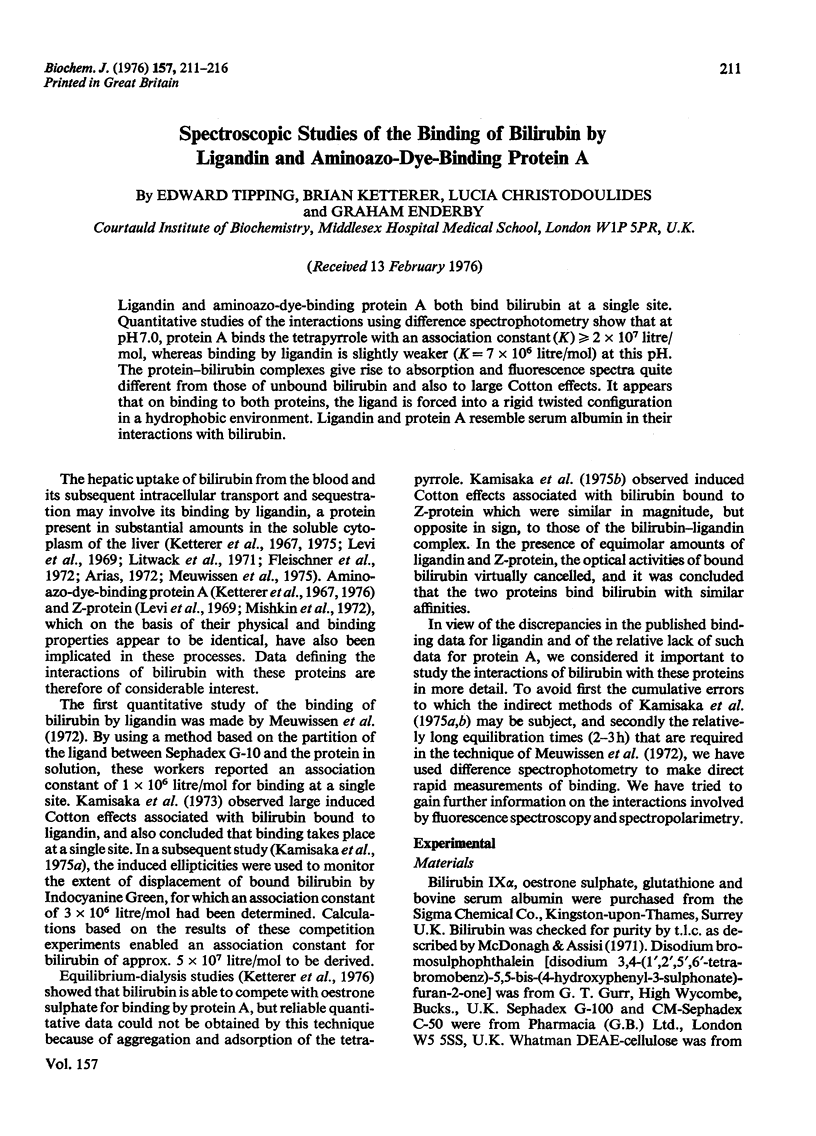
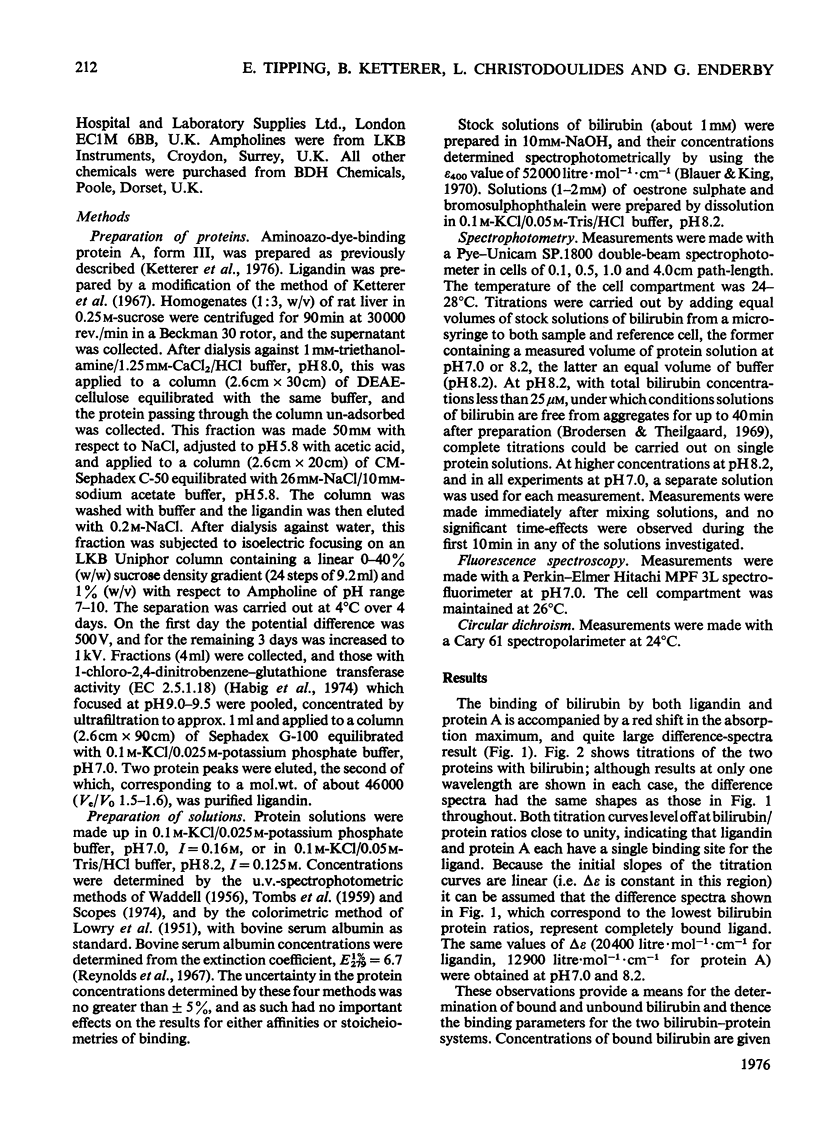
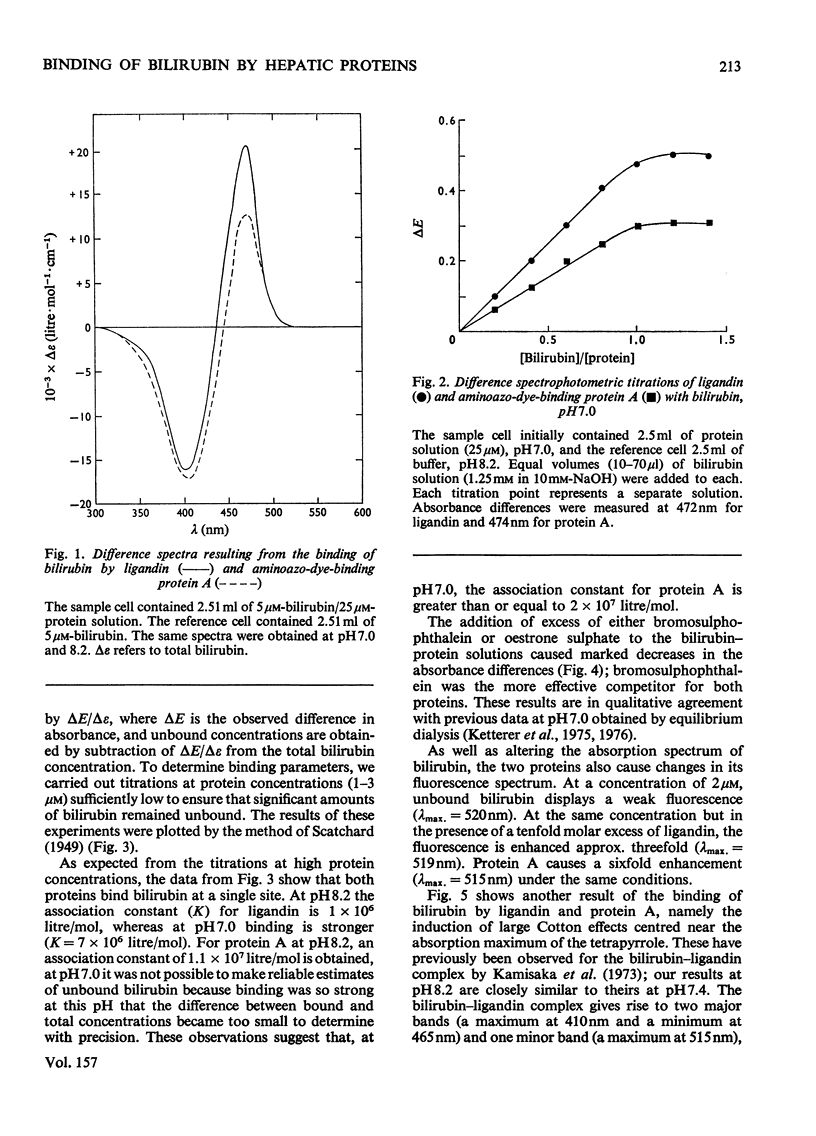
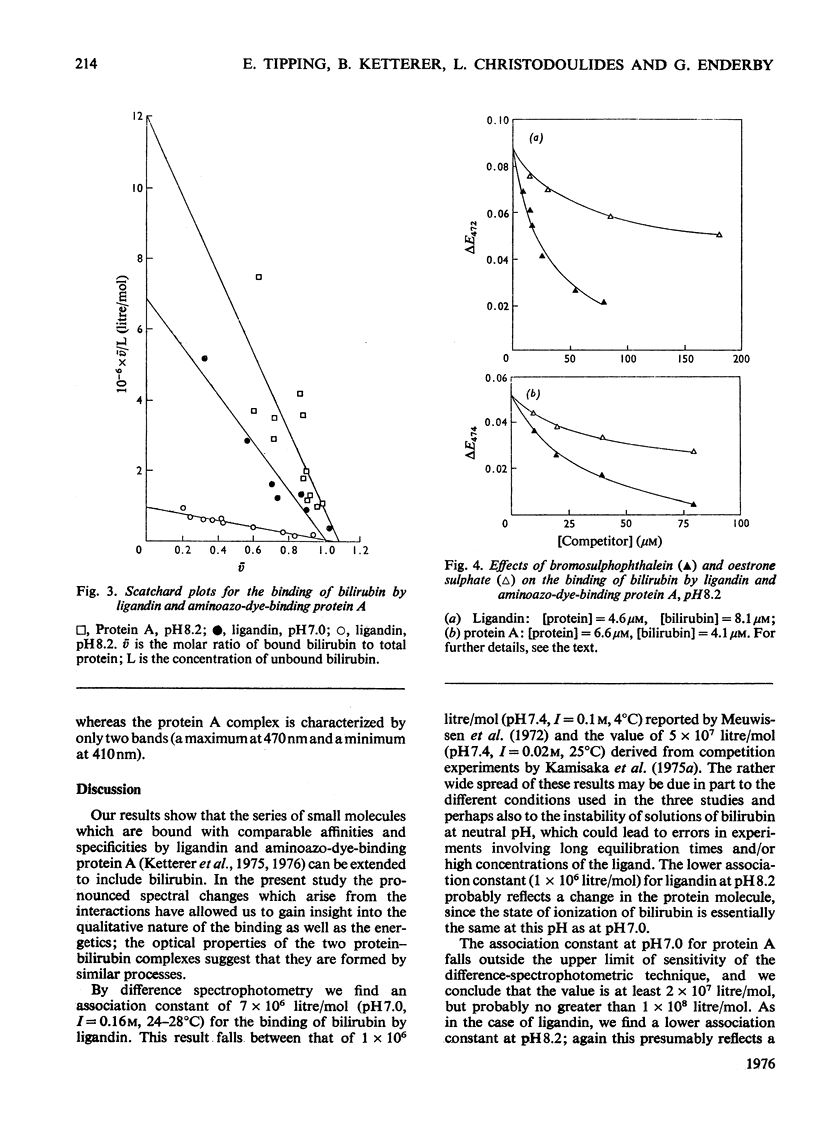
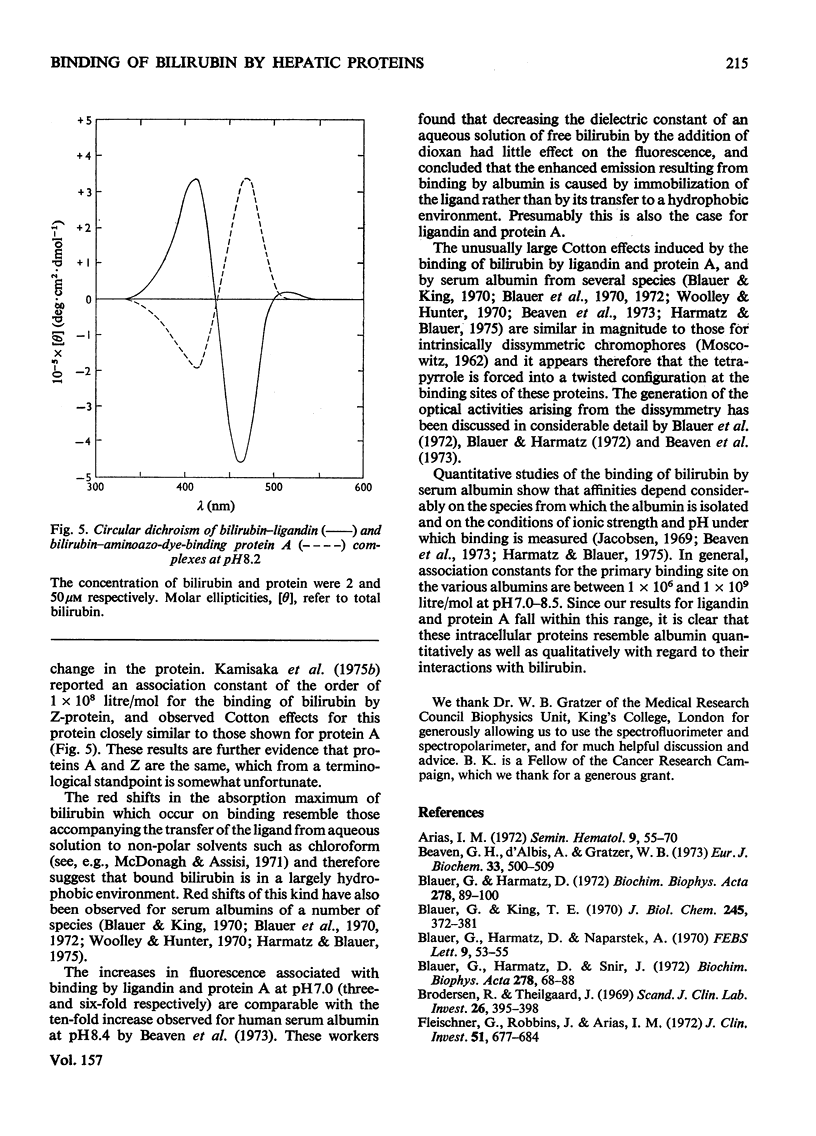
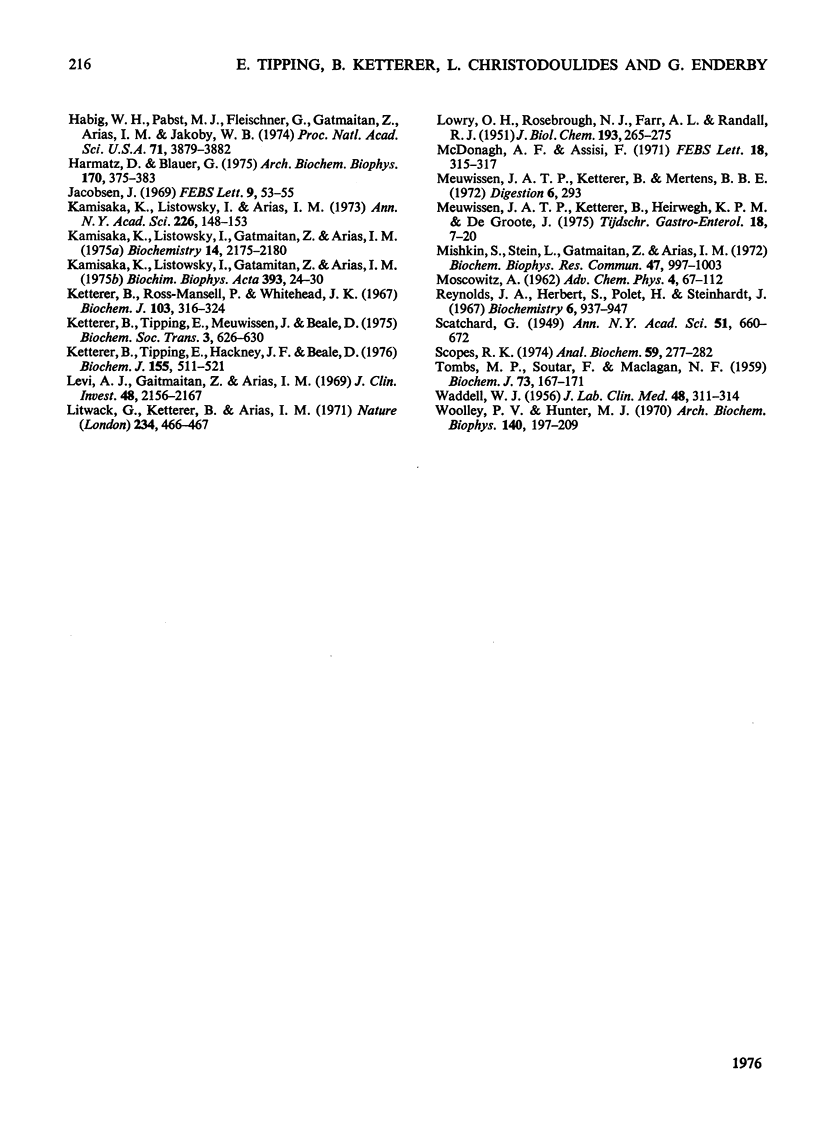
Selected References
These references are in PubMed. This may not be the complete list of references from this article.
- Arias I. M. Transfer of bilirubin from blood bile. Semin Hematol. 1972 Jan;9(1):55–70. [PubMed] [Google Scholar]
- Blauer G., Harmatz D., Naparstek A. Circular dichroism of bilirubin-human serum albumin complexes in aqueous solution. FEBS Lett. 1970 Jul 15;9(1):53–55. doi: 10.1016/0014-5793(70)80309-x. [DOI] [PubMed] [Google Scholar]
- Blauer G., Harmatz D. Optical properties of bilirubin-serum albumin complexes in aqueous solution. II. Effects of electrolytes and of concentration. Biochim Biophys Acta. 1972 Aug 31;278(1):89–100. doi: 10.1016/0005-2795(72)90109-2. [DOI] [PubMed] [Google Scholar]
- Blauer G., Harmatz D., Snir J. Optical properties of bilirubin-serum albumin complexes in aqueous solution. I. Dependence on pH. Biochim Biophys Acta. 1972 Aug 31;278(1):68–88. doi: 10.1016/0005-2795(72)90108-0. [DOI] [PubMed] [Google Scholar]
- Blauer G., King T. E. Interactions of bilirubin with bovine serum albumin in aqueous solution. J Biol Chem. 1970 Jan 25;245(2):372–381. [PubMed] [Google Scholar]
- Breaven G. H., D'Albis A., Gratzer W. B. The interaction of bilirubin with human serum albumin. Eur J Biochem. 1973 Mar 15;33(3):500–509. doi: 10.1111/j.1432-1033.1973.tb02709.x. [DOI] [PubMed] [Google Scholar]
- Brodersen R., Theilgaard J. Bilirubin colloid formation in neutral aqueous solution. Scand J Clin Lab Invest. 1969 Dec;24(4):395–398. doi: 10.3109/00365516909080178. [DOI] [PubMed] [Google Scholar]
- Fleischner G., Robbins J., Arias I. M. Immunological studies of Y protein. A major cytoplasmic organic anion-binding protein in rat liver. J Clin Invest. 1972 Mar;51(3):677–684. doi: 10.1172/JCI106856. [DOI] [PMC free article] [PubMed] [Google Scholar]
- Habig W. H., Pabst M. J., Fleischner G., Gatmaitan Z., Arias I. M., Jakoby W. B. The identity of glutathione S-transferase B with ligandin, a major binding protein of liver. Proc Natl Acad Sci U S A. 1974 Oct;71(10):3879–3882. doi: 10.1073/pnas.71.10.3879. [DOI] [PMC free article] [PubMed] [Google Scholar]
- Harmatz D., Blauer G. Optical properties of bilirubin-serum albumin complexes in aqueous solution. A comparison among albumins from different species. Arch Biochem Biophys. 1975 Oct;170(2):375–383. doi: 10.1016/0003-9861(75)90132-0. [DOI] [PubMed] [Google Scholar]
- Kamisaka K., Listowsky I., Arias I. M. Circular dichroism studies of Y protein (ligandin), a major organic anion binding protein in liver, kidney, and small intestine. Ann N Y Acad Sci. 1973 Nov 26;226:148–153. doi: 10.1111/j.1749-6632.1973.tb20477.x. [DOI] [PubMed] [Google Scholar]
- Kamisaka K., Listowsky I., Gatmaitan Z., Arias I. M. Circular dichroism analysis of the secondary structure of Z protein and its complexes with bilirubin and other organic anions. Biochim Biophys Acta. 1975 May 30;393(1):24–30. doi: 10.1016/0005-2795(75)90212-3. [DOI] [PubMed] [Google Scholar]
- Kamisaka K., Listowsky I., Gatmaitan Z., Arias I. M. Interactions of bilirubin and other ligands with ligandin. Biochemistry. 1975 May 20;14(10):2175–2180. doi: 10.1021/bi00681a021. [DOI] [PubMed] [Google Scholar]
- Ketterer B., Ross-Mansell P., Whitehead J. K. The isolation of carcinogen-binding protein from livers of rats given 4-dimethylaminoazobenzene. Biochem J. 1967 May;103(2):316–324. doi: 10.1042/bj1030316. [DOI] [PMC free article] [PubMed] [Google Scholar]
- Ketterer B., Tipping E., Hackney J. F., Beale D. A low-molecular-weight protein from rat liver that resembles ligandin in its binding properties. Biochem J. 1976 Jun 1;155(3):511–521. doi: 10.1042/bj1550511. [DOI] [PMC free article] [PubMed] [Google Scholar]
- Ketterer B., Tipping E., Meuwissen J., Beale D. Ligandin. Biochem Soc Trans. 1975;3(5):626–630. doi: 10.1042/bst0030626. [DOI] [PubMed] [Google Scholar]
- LOWRY O. H., ROSEBROUGH N. J., FARR A. L., RANDALL R. J. Protein measurement with the Folin phenol reagent. J Biol Chem. 1951 Nov;193(1):265–275. [PubMed] [Google Scholar]
- Levi A. J., Gatmaitan Z., Arias I. M. Two hepatic cytoplasmic protein fractions, Y and Z, and their possible role in the hepatic uptake of bilirubin, sulfobromophthalein, and other anions. J Clin Invest. 1969 Nov;48(11):2156–2167. doi: 10.1172/JCI106182. [DOI] [PMC free article] [PubMed] [Google Scholar]
- Litwack G., Ketterer B., Arias I. M. Ligandin: a hepatic protein which binds steroids, bilirubin, carcinogens and a number of exogenous organic anions. Nature. 1971 Dec 24;234(5330):466–467. doi: 10.1038/234466a0. [DOI] [PubMed] [Google Scholar]
- McDonagh A. F., Assisi F. Commercial bilirubin: A trinity of isomers. FEBS Lett. 1971 Nov 1;18(2):315–317. doi: 10.1016/0014-5793(71)80475-1. [DOI] [PubMed] [Google Scholar]
- Meuwissen J. A., Ketterer B., Heirwegh K. P., de Groote J. Ligandin. Tijdschr Gastroenterol. 1975;18(1):7–20. [PubMed] [Google Scholar]
- Mishkin S., Stein L., Gatmaitan Z., Arias I. M. The binding of fatty acids to cytoplasmic proteins: binding to Z protein in liver and other tissues of the rat. Biochem Biophys Res Commun. 1972 Jun 9;47(5):997–1003. doi: 10.1016/0006-291x(72)90931-x. [DOI] [PubMed] [Google Scholar]
- Reynolds J. A., Herbert S., Polet H., Steinhardt J. The binding of divers detergent anions to bovine serum albumin. Biochemistry. 1967 Mar;6(3):937–947. doi: 10.1021/bi00855a038. [DOI] [PubMed] [Google Scholar]
- Scopes R. K. Measurement of protein by spectrophotometry at 205 nm. Anal Biochem. 1974 May;59(1):277–282. doi: 10.1016/0003-2697(74)90034-7. [DOI] [PubMed] [Google Scholar]
- TOMBS M. P., SOUTER F., MACLAGAN N. F. The spectrophotometric determination of protein at 210 millimicrons. Biochem J. 1959 Sep;73:167–171. doi: 10.1042/bj0730167. [DOI] [PMC free article] [PubMed] [Google Scholar]
- WADDELL W. J. A simple ultraviolet spectrophotometric method for the determination of protein. J Lab Clin Med. 1956 Aug;48(2):311–314. [PubMed] [Google Scholar]
- Wooley P. V., 3rd, Hunter M. J. Binding and circular dichoism data on bilirubin-albumin in the presence of oleate and salicylate. Arch Biochem Biophys. 1970 Sep;140(1):197–209. doi: 10.1016/0003-9861(70)90023-8. [DOI] [PubMed] [Google Scholar]


